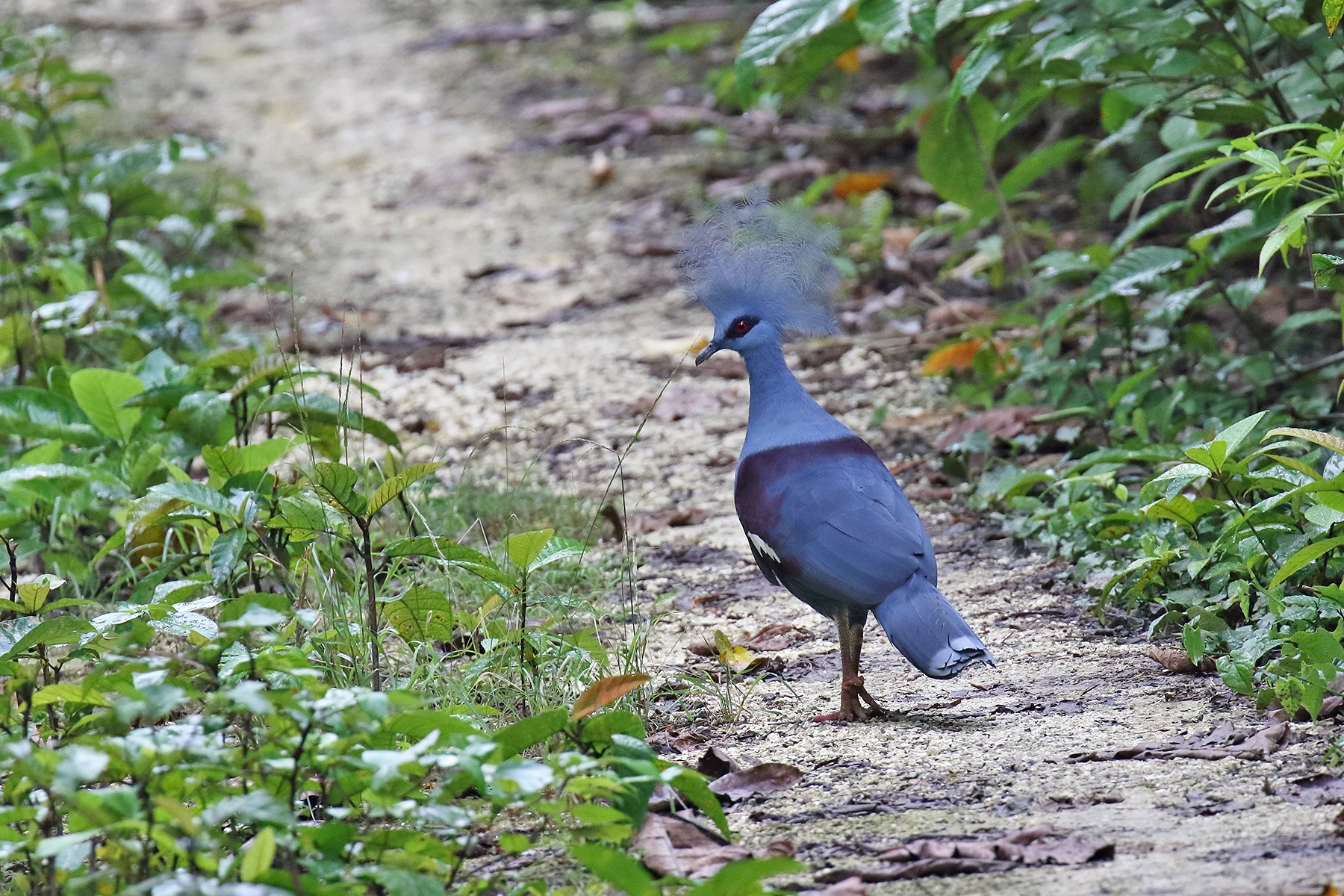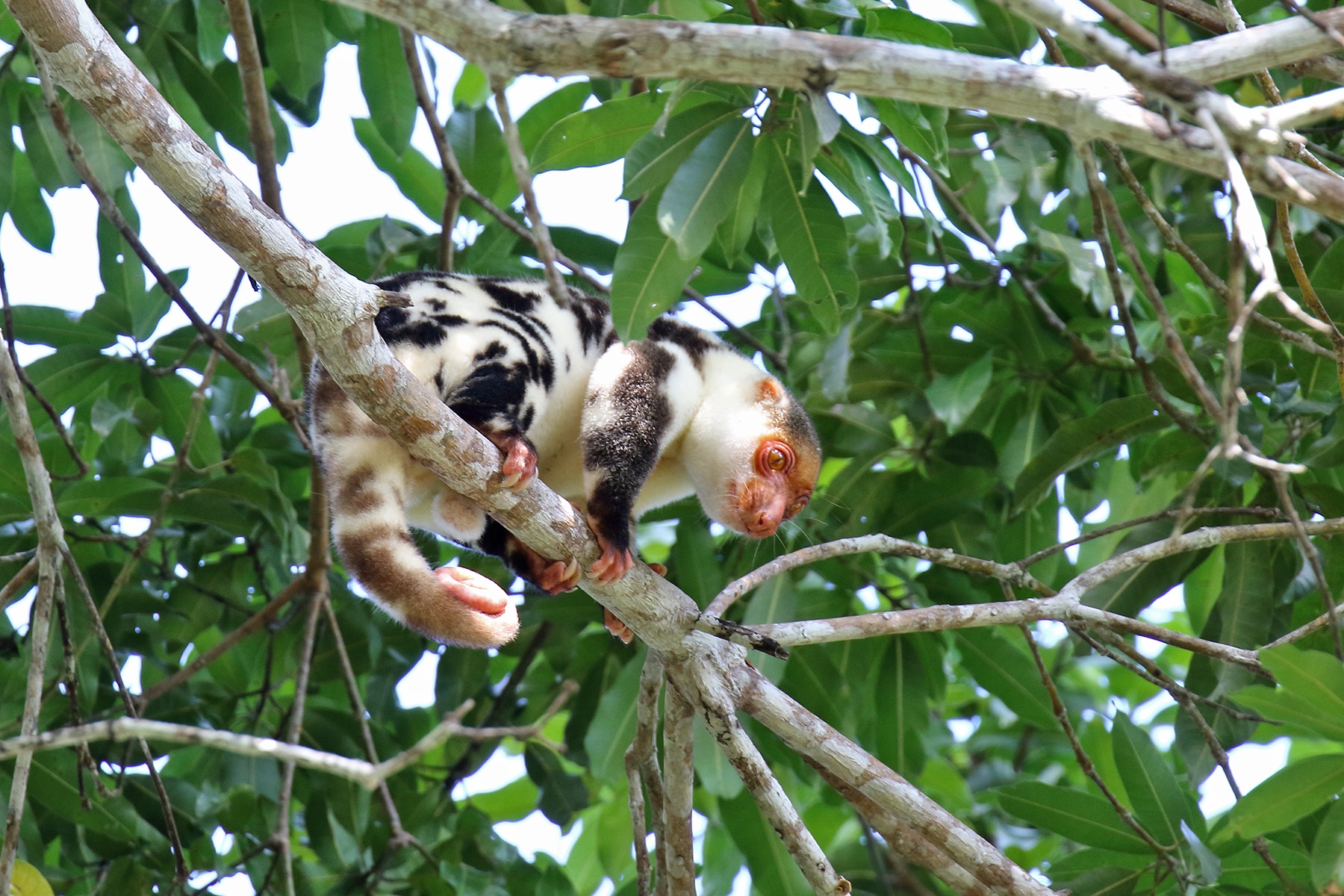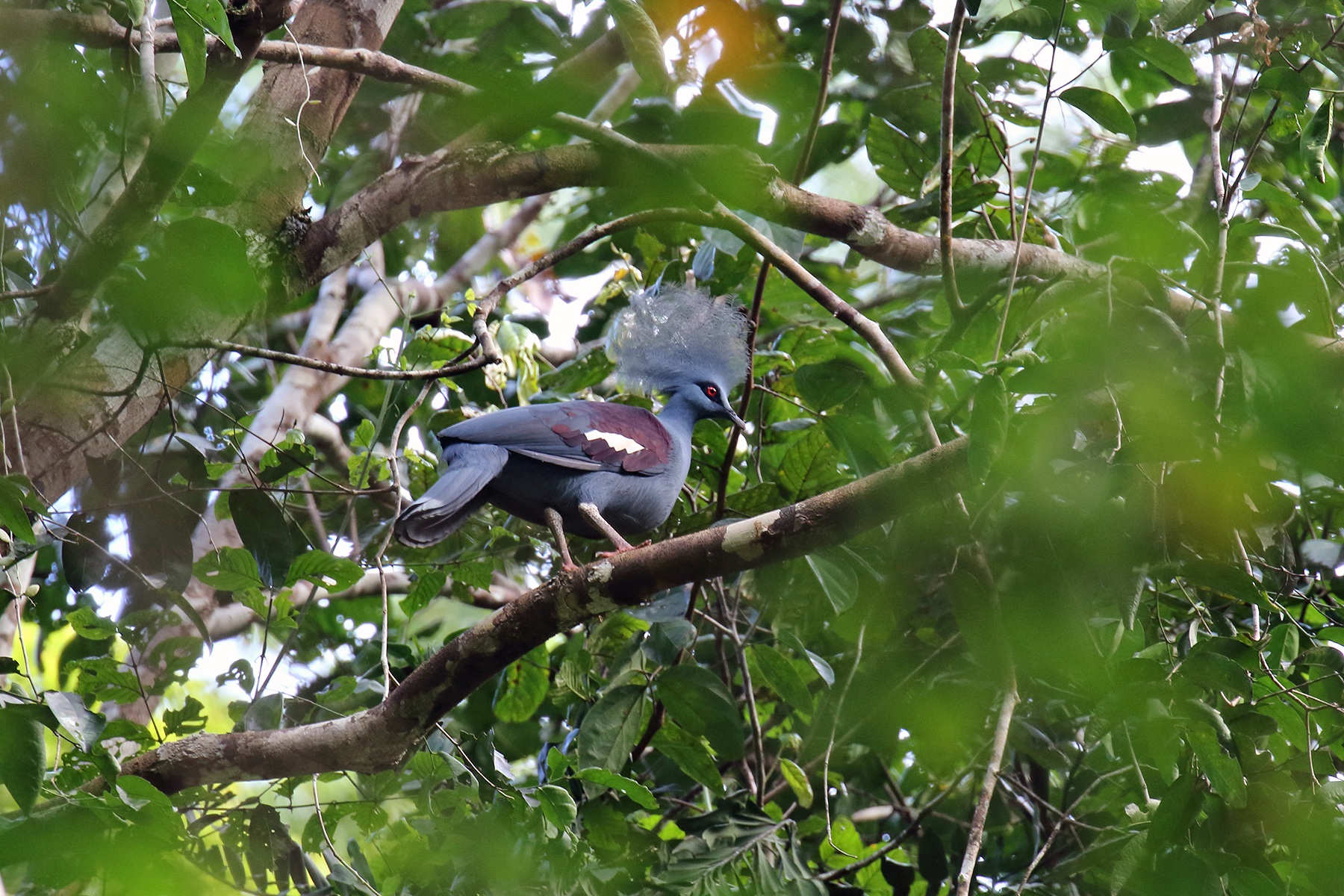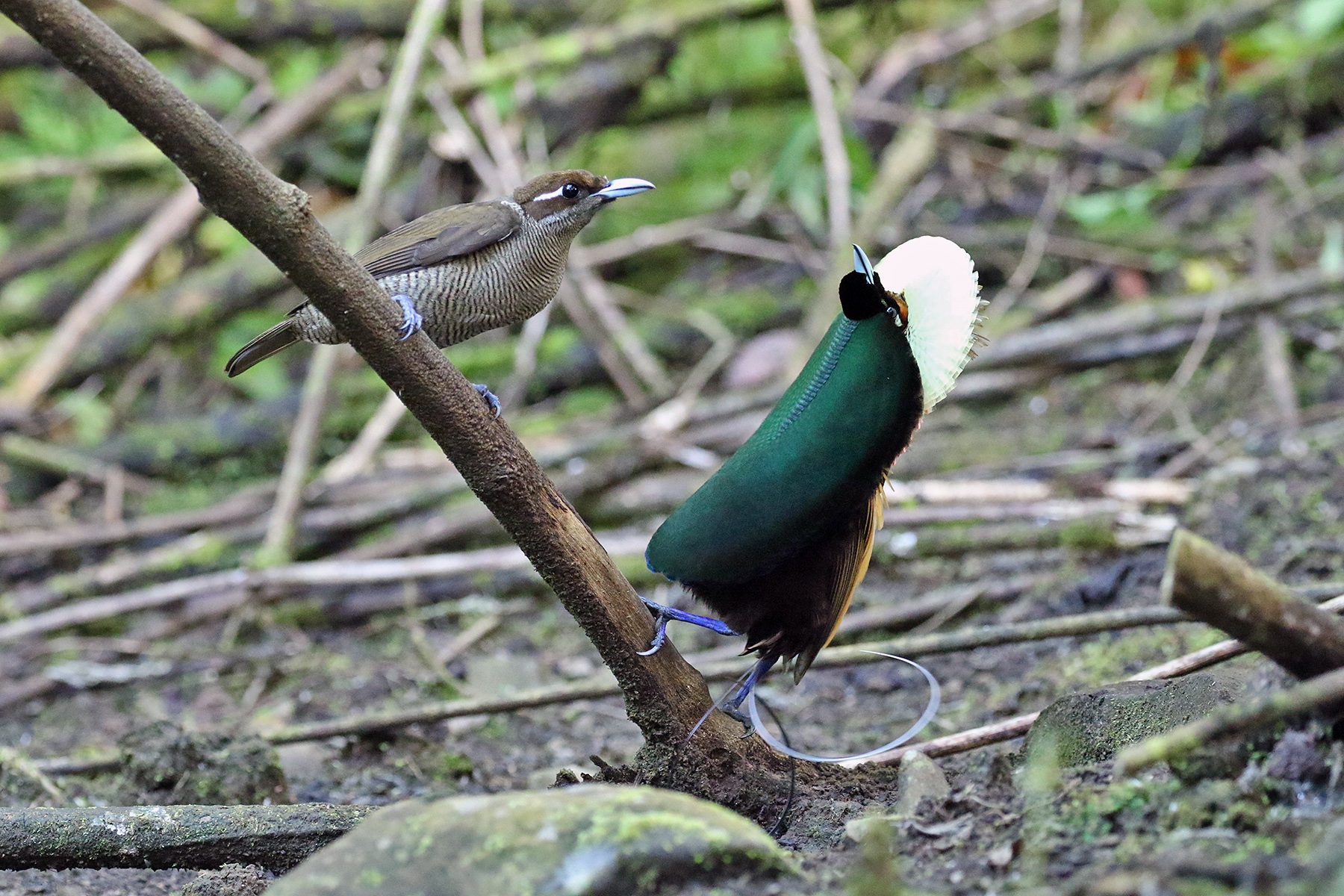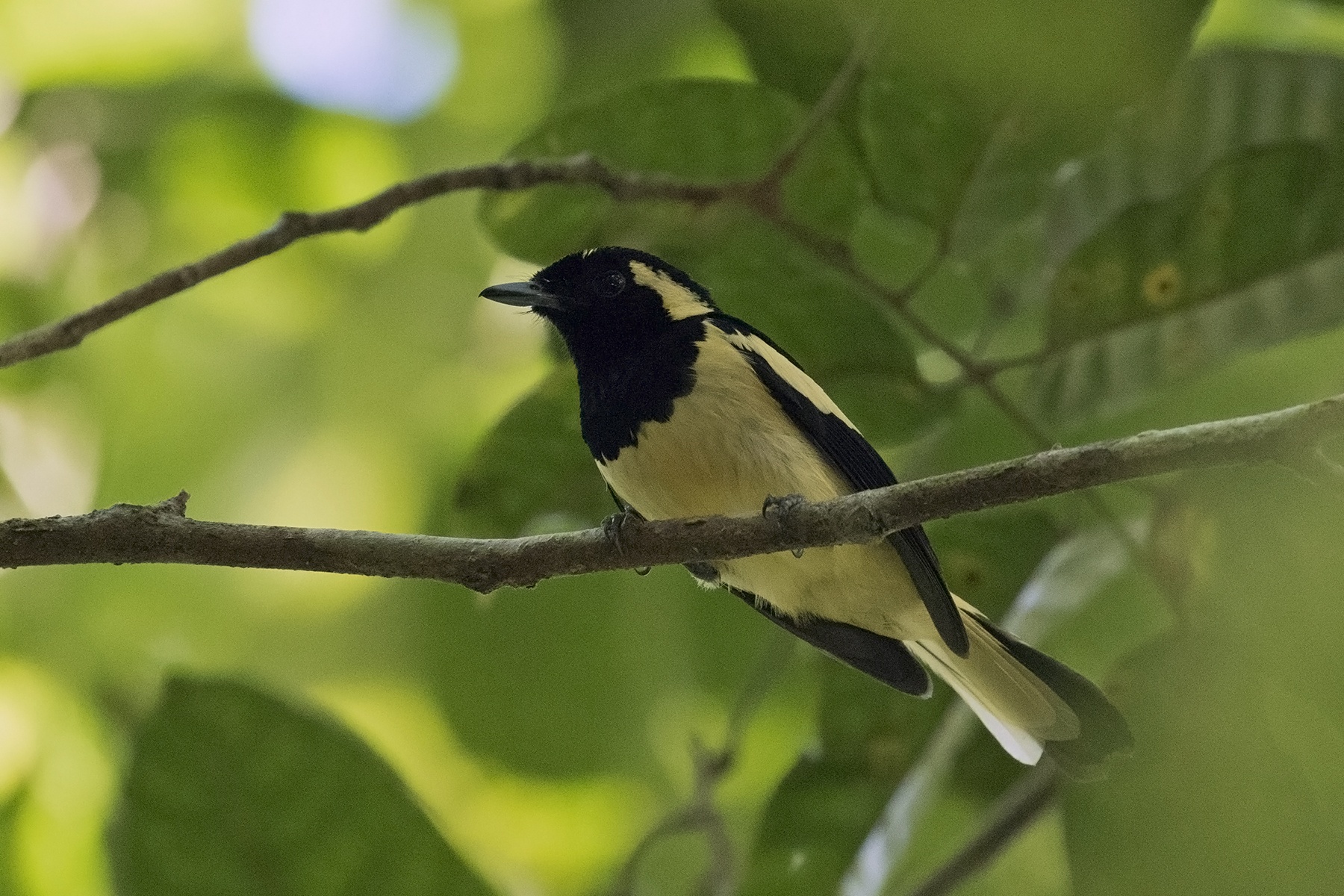CLASSIC WEST PAPUA BIRDING TOUR, INDONESIA: DETAILED ITINERARY
West Papua: Day 1 Our Classic West Papua birding tour begins this morning at Biak, an island in Geelvink Bay to the north of the New Guinea mainland, where we will stay for two nights. Later we will commence our exploration of the island.
West Papua: Day 2 Palm-fringed white sand beaches, ultramarine seas and coral ‘sea gardens’ are the best-known attractions of Biak and its sister island of Supiori, but these idyllic, rarely-visited islands also hold several endemic bird species, either restricted to these two islands or widely distributed amongst the islands of Geelvink Bay.
We will drive to an area of selectively logged forest where we shall hope to find the island’s specialities. The Biak Paradise Kingfisher is certainly the finest of Biak’s endemics and is still common, even in secondary habitat. Like most forest kingfishers this species spends much time perched still in one place but it gives itself away by constantly flicking its white tail streamers in time with its continuous calling.
Also common and vocal are Geelvinck Fruit Dove (restricted to Biak and other islands in Geelvinck Bay), Claret-breasted Fruit Dove, Spice Imperial Pigeon (the local form is sometimes split as Geelvink Imperial Pigeon) and Biak Triller. Flying rapidly overhead in pairs or small flocks, brilliant scarlet, endemic Black-winged (or Biak Red) Lories and Biak Lorikeets search out flowering trees. Endemic Biak Coucals can be found skulking clumsily in dense secondary scrub but can be hard to observe. The endemic Long-tailed Starling is still common, but seeing the shy endemic Biak Scrubfowl (or Biak Megapode) requires a bit of luck. The endemic Biak White-eye travels in small flocks, while the endemic Biak Gerygone favours a quiet life in the mid-canopy. Many of Biak’s birds join mixed feeding flocks which might include the diminutive endemic Geelvink Pygmy Parrot, the Biak race of the Common Cicadabird and the endemic Biak Myzomela, Biak Leaf Warbler, Biak Black Flycatcher and Biak Fantail. The little-known Biak Monarch will be our main target in the better-preserved stretches of forest. This attractive species often travels together with the distinctive local orange race of the Golden Monarch. We will also be looking for the the secretive Biak form of the Hooded Pitta and the endemic Biak Whistler, formerly considered a race of Little Shrikethrush!
Other species we should see include Pacific Baza, Brahminy Kite, Variable Goshawk, Great and Amboyna Cuckoo-Doves, Pacific Emerald Dove, Superb Fruit Dove, Eclectus Parrot, Uniform Swiftlet, Sacred Kingfisher, the introduced Sooty-headed Bulbul, Willie Wagtail, Black and Olive-backed (or Yellow-bellied) Sunbirds, and Hooded Butcherbird. Occasionally the rare Gurney’s Eagle can be seen gliding over the forest.
In the evening we will go out spotlighting in search of the endemic, but usually hard to see, Biak Scops Owl.
West Papua: Day 3 Today, weather permitting, we will travel by boat across to the island of Numfor for an overnight stay. We will spend our time on Numfor exploring different habitats. Numfor is situated to the southwest of Biak in Geelvink Bay and our main reason for visiting this lovely island is the occurrence of the fabulous endemic Numfor Paradise Kingfisher. This bright dark blue kingfisher with its gleaming white tail and bright yellow feet is quite common in all the habitats, so it should not take us too long to find and admire this magnificent endemic. Several other Geelvink Bay endemics occur on Numfor, and we will make an effort to find the distinctive endemic Numfor Leaf Warbler.
(While there is now a small airstrip on Numfor, the flight service there is extremely unreliable, because of a combination of schedule changes, weather issues and VIPs displacing booked passengers. For this reason boat travel remains the only practical means of visiting the island.)
West Papua: Day 4 After some final birding on Numfor we will return to Biak for an overnight stay.
West Papua: Day 5 This morning we will take a flight to Jayapura in eastern West Papua. The city’s airport is at Sentani, where will stay overnight.
Later today we will explore the nearby grasslands and the northern shore of picturesque Lake Sentani. Although the Cyclops Mountains which tower above the lake are still covered in primary forest, the foothills are now completely denuded with just a scattering of trees amongst the grassland.
The most interesting species here are Fawn-breasted Bowerbird and Great-billed (or Grand) and Hooded Mannikins.
Other birds we may well encounter in the area include Great Egret, Eastern Cattle Egret, Striated Heron, Whistling Kite, Collared Sparrowhawk, the crepuscular Spotted Whistling Duck, Pacific Black Duck, Brown and King Quails, Buff-banded Rail, the secretive Pale-vented (or Rufous-tailed) Bush-hen, Dusky Moorhen, Comb-crested Jacana, Orange-fronted and Orange-bellied Fruit Doves, the prehistoric-looking Channel-billed Cuckoo, Black-billed Coucal, Large-tailed Nightjar, Blue-tailed and Rainbow Bee-eaters, Dollarbird, Pacific Swallow, Tree Martin, White-bellied Cuckooshrike, Pied Bush Chat, Papuan Grassbird, Golden-headed Cisticola, White-shouldered Fairy-wren, Scrub and Mimic Honeyeaters (or Scrub White-eared and Mimic Meliphagas), New Guinea Friarbird, Chestnut-breasted Mannikin, White-breasted Wood Swallow, Glossy-mantled Manucode (our first bird-of-paradise!) and Torresian Crow.
We can also admire a huge roost of Great Flying Foxes.
West Papua: Day 6 In the morning we will fly southwards to Wamena, a small town situated at 5250ft (1600m) in the Grand Baliem Valley, where we shall spend the next four nights.
This afternoon we will have the chance for some initial exploration of the highlands. We will visit a cultivated valley where we should see a number of open country species, including Brown Falcon, Mountain Swiftlet, Brown-breasted Gerygone, Island Leaf-Warbler, Baliem Whistler, Red-capped Flowerpecker, Western Mountain White-eye, Red-collared Myzomela, Ornate Melidectes, the very localized Black-breasted Mannikin and the striking Greater Lophorina.
West Papua: Days 7-9 The discovery of the fabulous 9 miles (15km) wide by 37 miles (60km) long Grand Baliem Valley by Richard Archbold in 1938 was one of the last great surprises of the ‘age of exploration’. In the midst of what was assumed to be endless uninhabitable, jungle-covered mountains he discovered the most densely populated and agriculturally rich highland valley in New Guinea. The stone-age inhabitants he found there, the Dani, have become famous for their neat villages set in green fields, their hospitality, their cannibalism and their fierce and glorious warfare. Apart from the last two traits, they have changed little in the last 50 years. The Dani people and their neighbours, the Yali, do not wear the splendid bird-of-paradise plumes that can be seen in some parts of Papua New Guinea, but are ‘phallocrypts’ or penis-sheath wearers. Although western clothes are becoming more popular, many people still wear nothing but the traditional penis gourd or grass skirt, even around the market in Wamena on a freezing cold morning. Most still live in their small villages of circular thatched huts within a fenced compound and tend fields of sweet potatoes.
During our time in the area, we shall hope to see many of the birds Archbold first found here. From Wamena, we will drive up through the forests covering the slopes of New Guinea’s central cordillera to the grasslands surrounding Lake Habbema, situated on a high plateau in sight of the craggy, frozen summits of the Jayawijaya Mountains, part of West Papua’s evocative Snow Mountains range. Here at dawn the prize of this high alpine plateau, the stunning Macgregor’s Honeyeater, descends from the surrounding pine-scattered hills to feed along the edge of the montane forest. They are shy birds but draw attention to themselves when they fly because of the loud swishing of their brilliant golden primaries. (Recent research has suggested that this splendid species is, in fact, an aberrant honeyeater rather than a bird-of-paradise.) The flowering alpine shrubbery in this area also harbours Sooty and Short-bearded Melidectes, both of which can be very confiding.
Out on the open alpine grasslands, small parties of Western Alpine Mannikins feed among the tree-ferns and we may also chance upon the rather Red Grouse-like Snow Mountains Quail. Island Thrushes actively forage along the edge of the grasslands, while endemic Orange-cheeked Honeyeaters favour shrubby patches. Lorentz’s Whistlers are readily located among the pines by their full, fluty song. Crossing the boggy grasslands, we will flush Alpine Pipits, while a nearby lake usually holds several pairs of Salvadori’s Teal as well as Little Pied Cormorant and Common (or Eurasian) Coot. Other birds in this area include Papuan Harrier, Nankeen (or Australian) Kestrel, Spotless Crake, Black-throated Honeyeater (with its bubbling song), Common Smoky Honeyeater, Mountain Firetail and Great Woodswallow. At dusk, we will hope to witness the display flight of the secretive New Guinea Woodcock and encounter the rare Archbold’s Nightjar.
We will also explore the moss-festooned cloud forest where from darker recesses, White-winged Robins sing their descending trill and red-eyed Lesser Melampittas keep themselves well hidden in the undergrowth. Easier to see on the forest floor is the Mountain Mouse-Warbler whose pleasant song is frequently heard at this altitude. Perhaps the rarest bird of this damp, moss-hung forest is Archbold’s Bowerbird, which builds its large untidy bower of dead ferns up near the timberline. If we are fortunate enough to find an active bower we may be lucky enough to see this retiring bird. Other species occurring at this altitude include Painted Tiger Parrot (of the form lorentzi, sometimes split as Snow Mountain Tiger Parrot), Large and Papuan Scrubwrens, Mountain Robin, Lesser Ground Robin, Fan-tailed Berrypecker and Mountain Peltops.
With a bit of luck, we will encounter the retiring and poorly-known Greater Ground Robin, which leads an unobtrusive life on the moss-covered forest floor, as well as Chestnut Forest Rail and Papuan Logrunner.
We will also spend some time in the lower montane forest. Here in the late afternoon and early morning Splendid Astrapias can easily be located by their strange ‘plik…plik-plik’ call. At regular intervals, the thrumming ‘tat-tat-tat’ call of the male Brown Sicklebill echoes through the forest. Fruiting trees hold Black-billed Cuckoo-Dove and the shy and quiet Brehm’s Tiger Parrot. The mixed-species flocks here often include Dimorphic, Black and Friendly Fantails, Rufous-naped Whistler, Papuan Treecreeper, Black Sittella and the remarkable Western Crested Berrypecker.
We should also see Black-mantled Goshawk, White-bibbed Fruit Dove, Papuan Mountain Pigeon, Fan-tailed Cuckoo, Rufous-throated Bronze Cuckoo, Hooded and Black-bellied Cuckooshrikes, Buff-faced Scrubwren, New Guinea Thornbill, Ashy (or Grey) Gerygone, Lemon-bellied Flyrobin, Black-breasted Boatbill, Black-throated and Slaty (or Blue-grey) Robins, Regent Whistler, Papuan Sittella, Grey-streaked and Marbled Honeyeaters, and Blue-faced Parrotfinch. Further along the trail, flowering trees attract colourful flocks of Plum-faced, Stella’s and Orange-billed Lorikeets and the noisy and ubiquitous Belford’s Melidectes.
West Papua: Day 10 This morning we fly back to Jayapura airport and drive to an area of lowland alluvial rainforest at Nimbokrang at the base of the Cyclops Mountains, where we will stay for three nights. The rest of the day will be spent exploring this exciting and bird-rich area.
West Papua: Days 11-12 There are now very few places in the world where flat alluvial rainforest, so easily cleared for agriculture, still exists to the extent it does in West Papua. Here logging and hunting have yet to have a significant impact, much pristine habitat remains and some excellent birds can be seen.
Our key targets here will be the extraordinary Victoria Crowned Pigeon, Blue-black Kingfisher, Papuan Hawk-Owl, Brown Lory, Salvadori’s Fig Parrot, Pale-billed Sicklebill and Jobi Manucode.
At dawn, the uncommon Pale-billed Sicklebill is sometimes to be seen perched high on dead snags, whilst fruiting trees attract Wompoo, Pink-spotted and Beautiful Fruit Doves, Double-eyed Fig Parrot and sometimes the little known Salvadori’s Fig Parrot. Twelve-wired Birds-of-paradise frequent the swamp forest and we will definitely be hoping to witness the display of this unreal-looking bird. Loud raucous calls should lure us to a display tree of the incredible King Bird-of-paradise. This red and white jewel favours vine-covered forest giants and we should see a male showing off his blue legs and green tail discs.
Overhead, noisy parties of Sulphur-crested Cockatoos, Brown and (Western) Black-capped Lories and the huge and magnificent Palm Cockatoo fly past in search of fruiting or flowering trees. Elegant Moustached Treeswifts sweep across the clearings and bullet-like Papuan Spine-tailed Swifts speed along the tracks. Feeding flocks may contain Rufous-collared and Spot-winged Monarchs, and Lowland Peltops. Gaudy Yellow-faced and Golden Mynas favour the higher canopy and along the road, Oriental Hobby can be seen hunting.
Blyth’s Hornbills are common and flocks of Streak-headed Mannikins feed along the verges, whilst inside the forest tiny Buff-faced Pygmy Parrots can be found foraging nuthatch-like on the trunks of large forest trees. The forest often resounds to the loud calls of Rufous-bellied Kookaburras and we may well encounter a noisy gang of the little known Brown-headed Crow. Where uprooted trees have created clear pools, the tiny jewel-like Papuan Dwarf Kingfisher hunts small fish and glissading calls will betray the presence of the glorious Blue-black Kingfisher.
Other species we hope to see here include Nankreen (or Rufous) Night Heron, Black Bittern, Long-tailed Honey Buzzard, Grey-headed Goshawk, Stephan’s Ground Dove, Coroneted Fruit Dove, Pinon and Zoe Imperial Pigeons, Red-flanked Lorikeet, Red-cheeked Parrot, Brush Cuckoo, Shining and Little Bronze Cuckoos, White-crowned and Dwarf Koels, Lesser Black and Greater Black Coucals, Papuan Nightjar, Glossy Swiftlet, the crepuscular Hook-billed Kingfisher, Boyer’s and Grey-headed Cuckooshrikes, the handsome Golden Cuckooshrike, Black Cicadabird (or Black Cuckooshrike), Papuan (or Rufous) Babbler, Emperor Fairy-wren, Rusty Mouse-warbler, Yellow-bellied and Large-billed Gerygones, Sooty and White-bellied Thicket Fantails, Northern Fantail, Shining Flycatcher, Yellow-breasted Boatbill, Black-sided Robin, Little Shrikethrush, Northern Variable and Rusty Pitohuis, Long-billed, Green-backed, Plain and Streak-headed Honeyeaters, Meyer’s Friarbird, Metallic and Singing Starlings, Brown Oriole, Spangled Drongo, Black Butcherbird, the unobtrusive Jobi Manucode, Lesser Bird-of-paradise and Grey Crow. We will hear the harsh calls of Collared (or Brown-collared) Brush-turkeys and see their large mounds, but observing this devilishly shy bird requires lots of luck.
A short drive away in the foothills there is a good chance of seeing Pesquet’s (or Vulturine) Parrots flying overhead. We will also devote some time to looking for the impressive Victoria Crowned Pigeon.
At night we will go out to look for mysterious Marbled Frogmouth, Papuan Frogmouth and Papuan Hawk-Owl. If we are particularly lucky we will observe a Shovel-billed Kookaburra (or Shovel-billed Kingfisher), a Blue Jewel-babbler or a Tan-capped Catbird.
West Papua: Day 13 After some final birding in these rich and hot lowland rainforests we will return to Sentani near Jayapura for an overnight stay.
West Papua: Day 14 Today we will fly from Jayapura to Manokwari on the western shore of Geelvink Bay, from where we will drive inland to the village of Mokwam, situated at 5250ft (1600m) in the Arfak Mountains.
We will spend most of our seven nights here in one or two of the local villages, but we will also camp for one or possibly two nights higher up in the mountains. In the late afternoon, we will start our exploration of this remote area.
West Papua: Days 15-20 In these seldom-visited mountains we shall hope to find many montane species, including some of New Guinea’s least known birds. On the high ridges, the shy and scarce Black-billed Sicklebill utters its Whimbrel-like song and Arfak Astrapias can be found foraging along the moss-bedecked branches. Even less well known is the Long-tailed Paradigalla, which has only been seen by very few birders since it was first described. Whilst uncommon and wary, it draws attention to itself by its powerful monotone whistle and can sometimes be seen feeding in Pandanus and other fruiting trees.
Females and immature males of the endemic Western Parotia are fairly common but to see an adult male it is usually necessary to locate a display ground by following up their harsh calls. Hides have been built at a couple of these dance courts and one of the highlights of the tour will be observing the incredible display of this exquisite species. To watch the dazzling ‘ballerina dance’ of this fabulous species at very close range is totally out of this world and has been described as one of the climaxes of a birding career.
Another characteristic species of the area is the endemic Vogelkop Bowerbird, which not only builds a magnificent bower decorated with colourful flowers, fruits and mushrooms but can imitate the songs of nearly all other species. In recent times a display site of the amazing Crescent-caped Lophorina has been found and if it remains active we will surely pay it a visit.
In the mid-montane forest, the feeding flocks hold Sclater’s and endemic Vogelkop Whistlers and the pretty Goldenface. Magnificent Birds-of-paradise occasionally join these flocks, but more usually call from close to their display grounds. A hide has been built overlooking the dance court of this lovely species, so we should be able to admire a male in full swing. Shy Arfak Catbirds attract attention by their mewing calls from the canopy. Attractive Spotted Jewel-babblers are fairly regular in these moss-festooned forests and with a modicum of luck, we will observe this wonderful but shy species in all its glory. Sometimes our man on the spot knows of a day roost of a magical-looking Feline or a cute Mountain Owlet-Nightjar.
After climbing well into the mountains we shall come to a clearing on the steep slopes of Gunung Nadim. From here, at dawn, before the clouds come in, the view down to the lowlands is magnificent. The forest here holds feeding flocks which include Black Monarch, the endemic Vogelkop Scrubwren, Black Pitohui and Red-breasted Pygmy Parrot.
Eventually, we shall reach the summit ridge, where Black Sicklebills sing from favourite perches and we may see the male making its amazing display on a favourite branch. Along the ridge, Orange-crowned Fairy-wren and Smoky and Ashy Robins are to be seen, while attractive Tit Berrypeckers can be found in fruiting bushes. Flowering trees attract Arfak (or Western Smoky) Honeyeaters, and Cinnamon-browed and the endemic Vogelkop Melidectes.
Other species we will be looking out for include White-throated Pigeon, Bronze Ground Dove, Rufescent Imperial Pigeon, Josephine’s, Papuan and Yellow-billed Lorikeets, Blue-collared Parrot, White-eared Bronze Cuckoo, Grey-green Scrubwren, Garnet, Green-backed and White-rumped Robins, Hooded Pitohui, Olive-crowned Flowerpecker, Black-fronted White-eye, Dwarf Longbill and Rufous-sided and Mountain Honeyeaters.
At night we will search for the delightful Papuan Boobook. If we are particularly lucky we will chance upon a rare marvel like Papuan Eagle or White-striped Forest Rail.
If we have time we will visit a different area in search of the rare Grey-banded Mannikin.
Mammals are scarce here, but we stand a fair chance of encountering the adorable Red-bellied Marsupial Shrew.
West Papua: Day 21 Today we return to Manokwari for a major clean up and an overnight stay. We will spend most of the day birding along the road, looking for species that favour lower elevations, including the almost fluorescent Masked Bowerbird.
West Papua: Day 22 Today we will catch a flight to the bustling town of Sorong at the head of the Vogelkop Peninsula.
From there, we will travel to the Klasow Valley where we will stay for two nights in some small village huts. The village which will be hosting us lies in the middle of a large tract of superb lowland forest, the likes of which is always extremely hard to access in New Guinea – often soon after a track or village is built in good habitat, the habitat is removed! The locals here however truly value their forest, and the number of remarkable species which are present is a tribute to that.
West Papua: Day 23 In addition to the tame village Northern Cassowaries which come in from the forest to be fed fruit most mornings, the forest holds a good number of these gigantic birds, and we may be lucky enough to come across one on the trails while we are concentrating on our main targets. Pride of place goes to the stunning Red-breasted Paradise Kingfisher which is usually an ultra-scare or cryptic species, but proves to be almost common in the valley. The Vogelkop endemic Black Lory is another somewhat tricky bird that is much more abundant here than in the degraded forest elsewhere, and we should see multiple parties flying overhead and feeding in the canopy. What truly makes the Klasow Valley special, however, is the long list of mega New Guinea endemics which have previously been almost entirely unknown and only irregularly occurring elsewhere on the island. Recent explorations of the forest by a handful of intrepid birdwatchers (our leaders included) has yielded repeat, and seemingly regular observations of Forest Bittern, Thick-billed Ground Pigeon, New Guinea Bronzewing, Papuan Nightjar, Papuan Hawk Owl, Black Thicket Fantail, and the somewhat drab but nevertheless exceptional Tawny Straightbill. We will definitely hear the astoundingly common and restricted Red-billed Brushturkey here, and we will hopefully bump into one by walking along quietly, along with four desirable BoPs – King Bird-of-paradise, Twelve-wired Bird-of-paradise, Magnificent Riflebird, and Lesser Bird-of-paradise.
Of course, there are not just rare birds here, and we will also be on the lookout for more widespread species including Large Fig Parrot, Cinnamon Ground Dove, Wompoo, Pink-spotted, Dwarf, Claret-breasted, Beautiful and Orange-bellied Fruit Doves, Purple-tailed Imperial Pigeon, Ivory-billed Coucal, Papuan Spine-tailed Swift, Long-billed and Plain Honeyeater, Papuan Babbler, Rusty Pitohui, Sooty and White-bellied Thicket Fantail, Dwarf Koel, Scrub Meliphaga, Ruby-throated Myzomela, White-eared Catbird, Grey Crow, Olive Flyrobin and Emporer Fairywren.
West Papua: Day 24 After some final birding in the Klasow Valley, we will return to Sorong and take the ferry to the island of Waigeo for a three nights stay.
West Papua: Days 25-26 The island of Waigeo to the northwest of Sorong is seldom visited. Still forest-covered and very sparsely populated, this island holds several species rare or absent on the mainland. In the lowland forest, Red Birds-of-paradise, endemic to the islands of Batanta and Waigeo, can be watched displaying in some of the taller forest trees. Purple-tailed Imperial Pigeons can be found in fruiting trees and the tiny Yellow-capped Pygmy Parrot might be seen hanging from the trunk of a forest giant. Another key species is the endemic Raja Ampat Pitohui.
A primary goal here is to find the brilliantly plumaged Wilson’s Bird-of-paradise, without a doubt one of the most beautiful birds on the planet. In the early morning, one or two males and several females gather at display grounds; usually, an area cleared of all leaf litter under a tangle of vines, where the male calls vigorously and displays to the females as they arrive. Hides have been built overlooking these dance courts, so we should be able to watch these stunning birds at our leisure.
With a modicum of luck, we will hear the low thrumming call of Western Crowned Pigeons and then track one or more down. These huge creatures usually flush up with explosive wing beats and find a perch from which to nervously watch their pursuers.
Other birds we may well see here include Dusky Megapode, Pygmy Eagle, Great-billed Parrot, Common Paradise Kingfisher, Papuan Pitta, Pale-billed Scrubwren, Green-backed Gerygone, Frilled Monarch, Grey Whistler, Yellow-bellied and Pygmy Longbills, Puff-backed Meliphaga, Tawny-breasted and Spotted Honeyeaters, and Torresian Crow. We will also have another chance for Brown-headed Crow. In the forest, one of the most frequent songs to be heard is the repeated descending trill of the Chestnut-breasted Cuckoo.
Along the shoreline, Great-billed Heron, Eastern Reef Egret, Raja (or White-headed) Shelduck, Eastern Osprey, White-bellied Sea Eagle and Beach Kingfisher can all be found.
One afternoon we will travel by boat to some islets where we should find Pied and Spice Imperial Pigeons, and Violet-necked Lory, as well as a roost of Great-billed Parrots.
West Papua: Day 27 After some final birding on Waigeo we will return by ferry to Sorong looking out for Lesser Frigatebird, the elegant Black-naped Tern, Greater Crested Tern and other seabirds during the journey.
Our last birding will be spent in Sorong itself at a nice stretch of mangroves where the scarce Blue-black Kingfisher is quite common, and we may also add Little Kingfisher, Pale-vented Bush-hen, Collared Imperial Pigeon, Orange-fronted Fruit Dove, Brown-backed Honeyeater and Streak-headed Mannikin.
West Papua: Day 28 Our Classic West Papua birding tour ends this morning at Sorong airport.




















